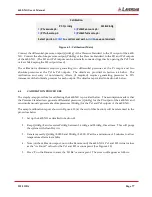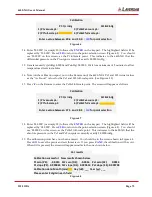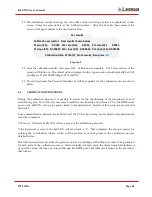
6600-NG User’s Manual
125-9110A
Page 86
2.
All commands sent to the 6600-NG are 2-letter commands. Both letters are capitals.
3.
Each command (followed by optional data) must be terminated by a Carriage Return <CR>
(0x0d).
4.
Multiple commands may be sent without any time delays between them. However, it is not
recommended to send more than 10 commands together, as this may cause the input buffer on
the 6600-NG to overflow.
5.
When a command is sent from the PC, the 6600-NG will always respond with some data. If the
command is a request for specific data, then this data will be returned. If the command is not a
request for data, the 6600-NG will respond with a ‘0’ or an error-code. If the command is invalid,
the 6600-NG will respond with an error code.
6.
Each response from the 6600-NG is terminated with a Carriage Return and Line Feed
<CR>(0x0d)<LF> (0x0a).
7.
When a command requires some data to be sent with it, the format is:
Command=data <CR>
However, there are several commands that can be used to either send data to the 6600-NG or to
request data from the 6600-NG. An example would be the ‘PT’ command associated with the Pt
Target value. To set the Pt Target value to 125.0 knots, the format would be : ‘PT=125.0’ <CR>.
To request the value of the current Pt Target the command would be ‘PT’ <CR>.
8.
The 6600-NG buffers commands as they are received, but processes them only at 250 msec
intervals. If there are 5 commands in the buffer, all 5 will be processed within one 250 msec
period. So it can take anywhere between 10 msec and 360 msec for the 6600-NG to respond to a
command, depending on when the command is received and the operating state of 6600-NG.
Note: While the 6600-NG is performing the Self-Test, it will not respond to any commands. The
commands will be buffered and processed only after the Self-Test is completed. The Self-Test
typically takes about 2 minutes to complete.
Note: Parameters shown in the Upper section of the Remote do not blink when set up through the
serial interface. However, they must still be either activated (using the GO command) or cancelled
(using the CN command). The Lower section of the display is not updated when commands are sent
through the serial interface.
The table below lists all the commands and details associated with each command.
















































